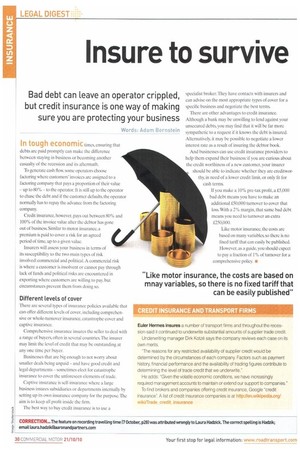Insure to survive
Page 30

If you've noticed an error in this article please click here to report it so we can fix it.
Bad debt can leave an operator crippled, but credit insurance is one way of making sure you are protecting your business
Wards: Adam Bernstein
In tough economic times, ensuring that debts are paid promptly can make the difference between staying in business or becoming another casualty of the recession and its aftermath.
To generate cash flow some operators choose factoring where customers' invoices are assigned to a factoring company that pays a proportion of their value —Up 10 80% — to the operator. It is still up to the operator to chase the debt and if the customer defaults, the operator normally has to repay the advance from the factoring company.
Credit insurance, however, pays out between 80% and 100% of the invoice value after the debtor has gone out of business. Similar to motor insurance, a premium is paid to cover a risk for an agreed period of time, up to a given value.
Insurers will assess your business in terms of its susceptibility to the two main types of risk involved: commercial and political.A commercial risk is where a customer is insolvent or cannot pay through lack of funds and political risks are encountered in exporting where customers are willing to pay. but circumstances prevent them from doing so.
Different levels of cover
There are several types of insurance policies available that can offer different levels of cover, including comprehensive or whole-turnover insurance, catastrophe cover and captive insurance.
Comprehensive insurance insures the seller to deal with a range of buyers, often in several countries.The insurer may limit the level of credit that may he outstanding at any one time per buyer.
Businesses that are big enough to not worry about smaller deals being unpaid — and have good credit and legal departments — sometimes elect for catastrophe insurance to cover the unforeseen elements of trade.
Captive insurance is self-insurance where a large business insures subsidiaries or departments internally by setting up its own insurance company for the purpose. The aim is to keep all profit inside the firm.
The best way to buy credit insurance is to use a specialist broker. They have contacts with insurers and can advise on the most appropriate types of cover for a specific business and negotiate the best terms.
There are other advantages to credit insurance. Although a bank may be unwilling to lend against your unsecured debts, you may find that it will be far more sympathetic to a request if it knows the debt is insured. Alternatively, it may be possible to negotiate a lower interest rate as a result of insuring the debtor book.
And businesses can use credit insurance providers to help them expand their business: if you are curious about the credit worthiness of a new customer, your insurer should be able to indicate whether they are creditworthy, in need of a lower credit limit, or only fit for cash terms.
If you make a 10% pre-tax profit, a 15,000 bad debt means you have to make an additional £50.000 turnover to cover that loss. With a 2% margin, that same bad debt means you need to turnover an extra £250,000.
Like motor insurance, the costs are based on many variables, so there is no fixed tariff that can easily be published. However, as a guide. you should expect to pay a fraction of 1% of turnover for a comprehensive policy. •




























































































































